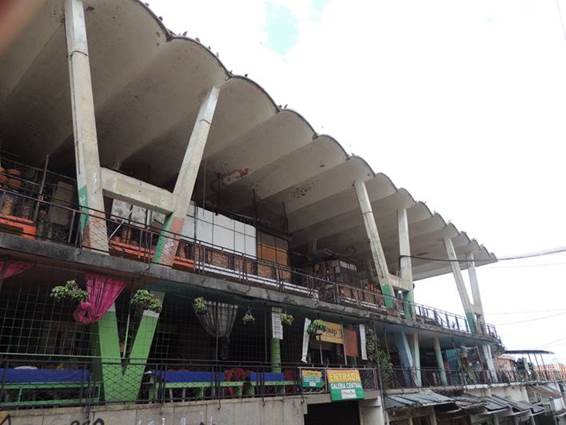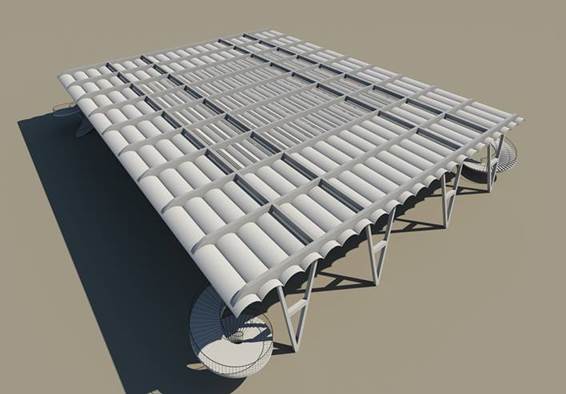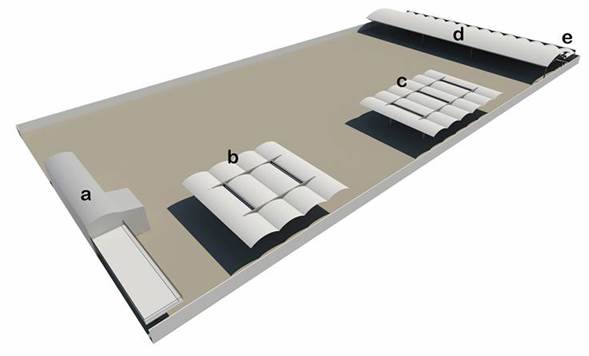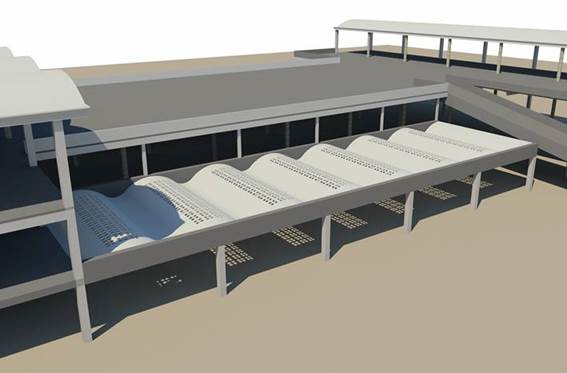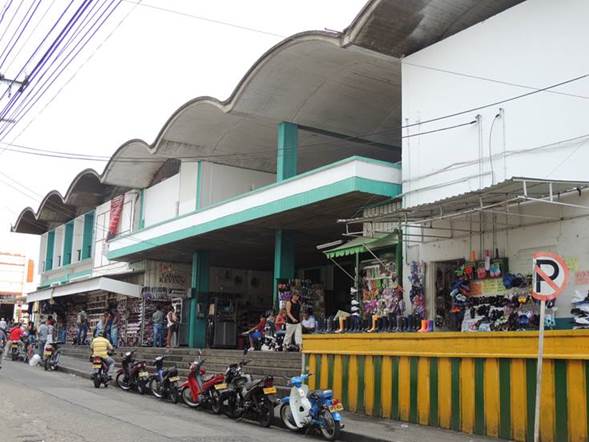Serviços Personalizados
Journal
Artigo
Indicadores
-
 Citado por SciELO
Citado por SciELO -
 Acessos
Acessos
Links relacionados
-
 Citado por Google
Citado por Google -
 Similares em
SciELO
Similares em
SciELO -
 Similares em Google
Similares em Google
Compartilhar
Revista de Arquitectura (Bogotá)
versão impressa ISSN 1657-0308versão On-line ISSN 2357-626X
Rev. Arquit. vol.20 no.2 Bogotá jul./dez. 2018
https://doi.org/10.14718/revarq.2018.20.2.2057
Proyecto arquitectónico y urbano
Cylindrical shells in Colombian architecture in the 20th century
* Arquitect, Universidad del Valle, Cali (Colombia). PhD in Architecture, ETSAB, Universidad Politécnica de Cataluña, Barcelona (España). Associate Professor, School of Architecture and Urbanism, Universidad Nacional de Colombia. http://orcid.org/0000-0001-6620-6392. jagalindod@unal.edu.co. Universidad Nacional de Colombia, Manizales (Colombia) School of Architecture and Urbanism
In 1946, cylindrical shells began to be designed in Colombia as a roof solution for industrial buildings, mainly replicating structural forms used in Europe and the United States since the beginning of the 20th century. This article describes and analyzes the first three projects of importance in Colombia, in which cylindrical shells were used through ingenious constructive resources. It defends the hypothesis that this initiative sought to take advantage of both the technical advantages and spatial attributes of these shells with a comprehensive view on the relationship between architecture, construction, and structure. Using a qualitative research method, available planimetric information was analyzed, and contrasted with buildings that are still standing and in service. The conclusions demonstrate how this type of structures, with their attributes and limitations, became a common resource in Colombian architecture in the second half of the 20th century.
Keywords: Colombian architecture; 20th century; membrane vaults; civil construction; project design; industrial buildings; architectural engineering
Desde 1946 se empezaron a diseñar en Colombia láminas cilíndricas como solución de cubierta para edificios industriales, principalmente, replicando formas estructurales empleadas desde los inicios del nuevo siglo en Europa y Estados Unidos. Este artículo describe y analiza los primeros tres proyectos de importancia construidos en el país (Mercado de Girardot, Estación de autobuses y Sede de Volkswagen en Bogotá) donde se emplearon láminas cilíndricas haciendo uso de ingeniosos recursos constructivos, considerando como hipótesis que esta iniciativa buscaba aprovechar tanto las ventajas técnicas como espaciales que ellas brindaban, dentro de una visión integral de la relación entre arquitectura, construcción y estructura. Como herramienta de investigación cualitativa se aplicó un análisis de la información planimétrica disponible, contrastada con los edificios que todavía se conservan. Las conclusiones demuestran la manera en que este tipo de estructuras, con sus atributos y limitaciones, se convirtieron en un recurso común en la arquitectura colombiana de la segunda mitad del siglo XX.
Palabras clave: arquitectura colombiana siglo XX; bóvedas de membrana; construcción civil; diseño de proyecto; edificios industriales; ingeniería arquitectónica
A partir de 1946, na Colômbia, teve início o desenho de estruturas laminares cilíndricas como solução de cobertura para prédios industriais, principalmente, replicando formas estruturais usadas desde princípios do novo século na Europa e nos Estados Unidos. Este artigo descreve e analisa os três primeiros projetos mais relevantes construídos no país (mercado de Girardot, estação de ônibus e sede da Volkswagen em Bogotá), nos quais foram usadas estruturas laminares cilíndricas com a ajuda de engenhosos recursos construtivos. Considera-se como hipótese que essa iniciativa buscava aproveitar tanto as vantagens técnicas quanto espaciais que elas brindavam, dentro de uma visão completa da relação entre arquitetura, construção e estrutura. Como ferramenta de pesquisa qualitativa, foi utilizada uma análise da informação planimétrica disponível, contrastada com os prédios que ainda estão conservados. As conclusões demonstram a maneira em que esse tipo de estruturas, com seus atributos e limitações, se converteu em um recurso comum na arquitetura colombiana da segunda metade do século XX.
Palavras-chave: arquitetura colombiana século XX; membrana; construção civil; desenho de projeto; prédios industriais; engenharia arquitetônica
Introduction
This article is a result of the research project entitled “Laminar concrete structures in Colombian architecture in the 20th century: Tradition and innovation,” which aims to identify the formal and construction characteristics of membranes designed and built in the country during a period of twenty years starting in 1946, by Colombian professionals with a knowledge of what was happening in the context of international architecture and, particularly, in the field of structural systems, seeking to cover large areas with reinforced concrete shells or reinforced ceramics, with minimum thickness and low own weight.
In particular, the paper will examine covers formed by sets of thin cylindrical shells, a structural type that Torroja (1957) would describe a few years later as “totally new,” which consists of placing “the cylindrical shell on rigid arches or transverse walls spaced and located according to the directrixes, that is, without the necessity of supporting it on the starting generatrices” (p. 120).
The hypothesis defended here is that such cylindrical sheets-also called barrel shells (Billington, 1965) and membrane vaults (Bonnelly, 1942, Bonnelly, 1945, Bóvedas membrana, 1950), dipteral vaults (Torroja, 1957 ), beam vaults (García, 2017) or laminar beams (Villazón, 2001)-were a technological resource used by Colombian architects and engineers since, in addition to their advantages in the optimization of materials used in construction, they simultaneously created a light and waterproof deck plan in the upper part, and a false ceiling on the lower side. The complex thus formed became a determinant of the configuration of the living space, and a dominant factor in the architectural image of the whole building.
How was the relationship between project and construction in buildings that used this structural system? What structural analysis tools were available and how did they influence the results obtained? What technical-constructive resources were used by architecture and engineering professionals to materialize them? These are the most relevant research questions formulated in this paper in light of the above mentioned hypothesis.
From the most outstanding examples of this type of structures in Colombia, three projects have been chosen as an object of study for this paper: the market in Girardot (1946-1954), designed by the German architect Leopoldo Rother, and two buildings in which Guillermo González Zuleta participated as a structural engineer: a bus terminal in Bogotá (1950-1951), demolished today, and the headquarters of the Volkswagen Group (1954-1955), also in Bogotá. Although these buildings have been reviewed in the historiography of Colombian architecture (Arango, 1989; Niño, 2003, mainly), there is no record of studies that were based on construction and structural considerations.
It is important to note that after the construction of the last mentioned building, the use of cylindrical roof shells spread throughout the country, during a period of time that lasted until the last years of the 1980s, evidenced in important examples that include the headquarters of the Inter-American Housing Center (CINVA, for its initials in Spanish)1 (1953) in Bogotá; the Hippodrome of Techo (1953-1955), also in Bogotá; the Civic Center in Barranquilla (1955), the La Libertad stadium in Pasto (1955), the market building in Buga (1960), the prison in Popayán (1962), and the courthouse in Cúcuta (1988), among many others.
Methodology
The research method used in this paper was of qualitative nature, based on archival research that recorded and analyzed planimetric information about the projects under study, which was complemented with an analysis of historic photos from the period and direct visual inspection of the constructed buildings, when possible. The original plans of the Girardot market are currently in the INVÍAS Fund of the General Archive of the Nation, while those corresponding to the bus terminal and the Volkswagen headquarters are in the Guillermo González Zuleta Fund of the Archive of Bogotá. Photographs of these last two buildings can be found in various issues of the journal Proa.
Based on the information gathered during the research, a descriptive and comparative analysis was carried out that focused on the following aspects: the geometrical and dimensional characteristics of cylindrical shells used in each building, connections between them and support systems, construction materials used in their construction, and mechanisms for the evacuation of rainwater put into practice. Regarding the limitations of the study, there are aspects not addressed in this text that could be developed at a later stage and are considered important; these are: analysis of the conservation state, analysis of the mechanical behavior under current conditions, and characterization of their constituent materials.
The first part of the article briefly explains the mechanical behavior of cylindrical shells in order to fully understand the challenge involved in their design and construction at a time when no sophisticated calculation methods existed. Subsequently, the paper describes their origin in the context of international architecture and explores technological links between developments produced by Colombian architects and engineers and the rest of the world in the field of laminar structures. Finally, and prior to the discussion section and conclusions, it presents a description of the aforementioned buildings based on the methodology described.
Results
Geometry, mechanical behavior, and the construction of cylindrical shells
In essence, laminar structures are those whose geometry corresponds to a thin and continuous surface, where two of its dimensions predominate over the dimension of thickness; their behavior is based on the fact that all internal stresses are normal, be they traction or compression, and tangential. For this to occur, the load that acts on the structure must preferably be “uniformly distributed and should not present sudden variations or punctual loads” (Morales, 2009, p. 940), in such a way that its mechanical resistance is considered a virtue of its form.
In general terms, laminar structures (also called active surface structures) can be classified into three groups (Engel, 1970): without curvature (folded sheets, for example), with simple curvature (like the cylindrical shells studied here), and with double curvature (as in the case of hyperbolic paraboloids). In the case of singly curved shells, their structural behavior can be explained in light of the membrane theory, which assumes that all stresses are tangent to the shell and are evenly distributed in its thickness (Candela, 1951), in such a way that only two-dimensional stresses are developed along its surface (Salvadori & Heller, 1966). Flexural rigidity and shear stiffness are negligible, as is resistance to compression (Figure 1).
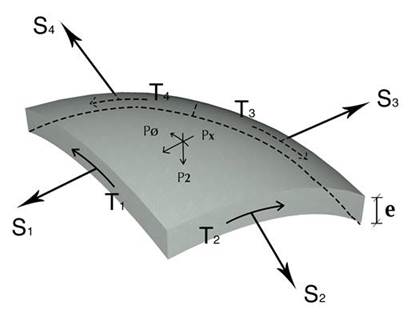
Source: Laura Henao, 2018, CC BY.
Figure 1 Two-dimensional stresses considered in membrane-type structures
In the particular case of simple cylindrical shells, with horizontal and symmetrical axes, and according to specialized literature (Billington, 1965), they can be differentiated into short and long according to their support conditions and structural behavior. Thus, the so-called short ones are those that rest on their longitudinal edges (or generatrices) and have a ratio r/L>0.6 (where r is the interior radius of the directrix and L is the length of the membrane), while the long ones, at a ratio of r/L<0.6 (ASCE, 1952), rest on their ends (or on the lines of the generatrices) and exhibit a similar behavior to a beam (Figure 2a).
In any case, cylindrical shells should not be confused with vaults, despite similarities in their shape, since both have a different mechanical behavior (Torroja, 1957). The behavior of vaults is based on the interconnection of parallel arcs that transmit the same stress on continuous supports under the generatrices; they are usually constructed with materials resistant to compression and their thickness can sometimes be considerable. On the other hand, cylindrical shells behave in a similar way to longitudinal prismatic beams, although characterized with a curved profile and reduced thickness, and are capable of covering large spans without continuous lateral supports and with a predominance of bending stresses.
Thus, when a cylindrical shell comes under load, even under the action of its own weight, the generatrices get deformed, curving in such a way that the area located in the lower part of the shell works with tension and the upper part works with compression (Figure 2b). If the thickness of the shell is small in relation to its length, this flexion is reduced and has little influence on its general behavior.
From the point of view of construction, cylindrical shells can be made of reinforced concrete or reinforced ceramics. In both cases, the manufacturing process follows the same sequence: formwork (from straight molds since it is a developable surface), reinforcing (continuous or reticular depending on whether it is in concrete or ceramics, respectively), concreting (complete or on the small beams in the same cases), and uncasing. Depending on the number of shells and their dimensions, it can be a repetitive or simultaneous process, where it is possible to reuse the molds, which always implies savings in the quantity of constituent materials.
Genesis of cylindrical shells
The origin of cylindrical shells in the first decades of the 20th century is closely related to the advances made by the German company Dyckerhoff & Widmann AG (Dywidag), under the guidance of two of its most prominent engineers: Franz Dischinger and Ulrich Finsterwalder (Stegmann, 2009), responsible for calculating the first thin roofs in reinforced concrete: the Zeiss Planetarium in Jena2 (1922), which had a circular plan with a 25 m radius and a spherical shell thickness of 6 cm (Figure 3); the market in Frankfurt am Main (1927), where each cylindrical vault covered a surface area of 50 x 17 m, and the market in Leipzig (1929), that had two twin domes on octagonal layouts with a diameter of 65.8 m, among others (May, 2012).
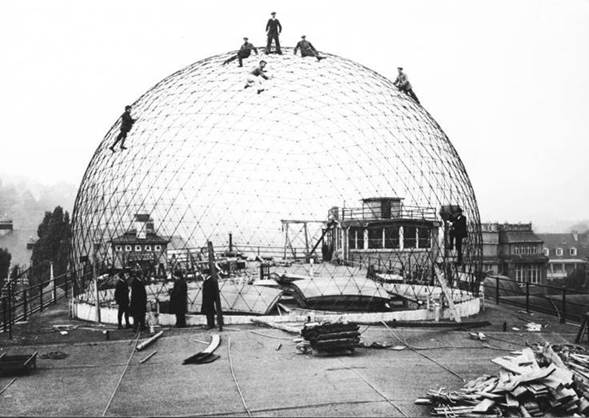
Source: Cassinello, Schlaich & Torroja (2010).
Figure 3 Dome in Jena (1922), by Dyckerhoff & Widmann AG
Thanks to the first of these projects, Dischinger obtained-jointly with his partner in this work, Walther Bauersfeld-the patent that ended up being known as the “Zeiss-Dywidag system of thin roof shells” (Billington, 2013) or “Z-D system.” In this case, steel bars were arranged following tension trajectories, with specially located reinforcements in the corners and other singular regions subjected to stresses. The diffusion of this system in the following years was due to a well-planned commercial strategy that led Dywidag to build laminar structures in several European countries, and even in Latin America: subsidiaries of this German company based in Uruguay and Argentina built at least seven concrete membranes in the period between 1929 and 1933, either through direct contracting or through technical consulting during the construction process. In any case, between 1923 and 1939, the systems patented by Dywidag were used in at least 35 countries, and reached more than 280,000 m2 of covered area (May, 2015).
In the specific field of the structural analysis of cylindrical shells, the works of Knud W. Johansen (1944) and Hegel Lundgren (1949) were added to those developed by Dywidag engineers. Lundgren made use of classical equations in the analysis of beam bending in order to determine longitudinal tensions, and combined them with an analysis of the arc-shaped part of the structure to find the value of transverse bending moments. This same principle was used by Félix Candela in the design of his first long cylindrical shell for the roof of the Almacén Pisa in 1951 (Martínez & Echeverría, 2017), as well as by the Uruguayan engineer Eladio Dieste in calculating several of his membranes built in reinforced ceramics since 1959 (Cabeza & Almodóvar, 1996). Similarly, this calculation system was still used in the structural design made by August Komendant for the Kimbell Art Museum, designed by Louis Kahn in 1972 (Buonopane & Osanov, 2015).
In Colombia, interest in laminar structures was manifested early and especially in the academic field at the Universidad Nacional, as evidenced by articles published since 1939 in the journal Ingeniería y Arquitectura, printed publication of the university’s Faculty of Engineering, where both professors and students, as well as international guests participated with articles. Thus, the first note on the subject published in the journal was written by the Dominican engineer Rafael Bonnelly, who aimed to find “practical formulas that facilitate the rapid design of membranes, to overcome thus the limitations imposed by patents” (Bonnelly, 1942, p. 18), which then restricted knowledge about the calculation of cylindrical shells.
His explanation was developed based on the case of a semi-cylindrical vault in reinforced concrete of 84 m long, 40 m wide, and 7.5 cm thick, for which values of inertia moment, stresses, and the section of steel bars were determined through a simplified, but mathematical process. Three years later, Bonnelly would submit to the journal Ingeniería y Arquitectura a detailed and illustrated review of a laminar vault built by himself in Santo Domingo, which verified in practice his theoretical appreciations (Bonnelly, 1945).
Another sign of academic interest in the calculation of laminar structures in Colombia is manifested through a series of studies translated into Spanish by Professor Julio Carrizosa and published in Ingeniería y Arquitectura (Pucher, 1943a, 1943b). These articles divulged in the country the methods developed by the German engineer Adolf Pucher, who, in addition to having worked for Dywidag, would be well known in Latin America for his textbook on reinforced concrete (Pucher, 1958), used in the training of civil engineers.
For his part, in 1944, Henry Cornelissen, engineer and professor at the Universidad Nacional, described in the same journal new modes of analysis for cylindrical shells, based on two outstanding methods for the solution: those of Dr. U. Finsterwalder and Dr. F. Dischinger, respectively, “given that today the calculation of these structures is too complicated and laborious for engineers not specialized in this area” (Cornelissen, 1944, p. 5). As examples, the author mentions the roofs of the Budapest Market Hall (1931), with membranes of 41.5 m span length, 12 m width and 6 cm thickness, designed by Finsterwalder, and the Hershey Arena, designed by the engineer Anton Tedesko (1936) in the United States. The article’s bibliography included authors such as Dischinger, Finsterwalder, Moltke and Kalinka, Schorer, Tedesko and Timoshenko, all of great influence in the field of calculation of reinforced concrete membranes.
In addition to academic publications, the physical presence of the Spanish engineer Eduardo Torroja in the Colombian context was very important, who stayed in Bogotá for five days in 1952. On that occasion, he gave several conferences, among which one was entitled “Doubly and simply curved laminar roofs” (Escobar & Cárdenas, 2006), in which he explained the mechanical principles of cylindrical vaults, among other things.
By then, many of the buildings designed by Torroja were already recognized by the international community, among which his project of a recessed dome with a curvature radius of 44.1 m and a thickness of 9 cm for the Algeciras market (1934) stands out. However, his most famous project would be the roof for the La Zarzuela Racecourse (1935) in Madrid, equipped with double curvature shells, without ribs, that extends 12.7 m from the support towards the track, with 5.3 m width in each of its modules and a thickness of 5 cm at the end of the cantilever. Additionally, in the field of cylindrical vaults, his design for the roof of the Frontón Recoletos stands out, also in Madrid, designed with two semi-cylindrical lobes of simple curvature, in reinforced concrete (García, 2017).
In this last project, which unfortunately was partially destroyed during the Spanish Civil War, Torroja had deliberately eliminated the possibility of constructing a thick prismatic beam under the line where the two laminar vaults were joined (Figure 4). In his words, “if there exists a longitudinal beam, it is constituted by the same shell, which, leaving behind the narrow mechanical frame of prismatic pieces, develops a resistance process that is much more complex and complete, but no less defined” (Torroja, 1936, p. 4).
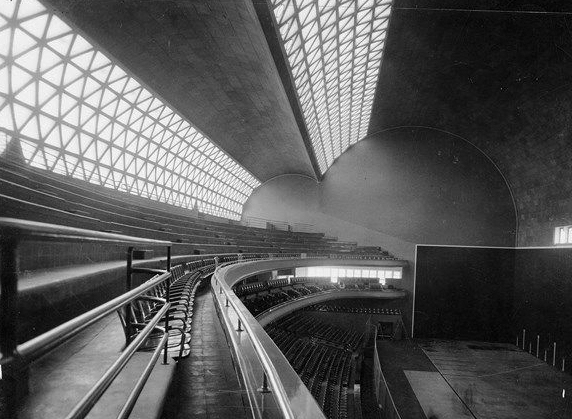
Source: Cassinello, Schlaich & Torroja (2010).
Figure 4 Frontón Recoletos (1935), Madrid, by Eduardo Torroja
After the Second World War, cylindrical shells were extended throughout the United States and Europe as a roofing solution for industrial buildings, warehouses, vehicle exhibition halls and sports venues, among others, with a special care in their geometric form, the way of their support, and the construction process, giving rise to a singular typological variety (García & Osuna, 2009). This phenomenon coincides with an interest aroused by this design in engineers and architects in Colombia, who already had the mathematical apparatus necessary for its structural calculation, and who aimed to develop an experimental work in the construction field in order to achieve practical and versatile structures at a low cost.
It is no coincidence that the interest of Colombian professionals in the design and construction of light roofs with large spans came at a time when the country was beginning an industrialization process in its most important cities. Such situation made it necessary to design new spaces with good lighting and ventilation conditions, but without intermediate supports that would hinder the equipment, and especially at a low cost so that its construction would be viable.
Case studies in Colombian architecture
The interest in laminar structures has already been demonstrated in the academic context of the Universidad Nacional de Colombia, which was manifested in articles written by foreign professors and collaborators who worked at the university; however, in the field of practice, the first constructions of this type were slow and progressive.
Thus, it is known that between 1942 and 1946 the architect José María Montoya Valenzuela and the engineer Fausto Galante built vaults in reinforced concrete to cover the chapel of the Minor Seminary of Bogotá, but its influence in the local and national context was limited. It was the German architect-engineer Leopoldo Rother who would made the first attempt to take advantage of the benefits of flat or slightly curved laminar structures, as evidenced by two separate projects for the Universidad Nacional de Colombia: the Alfonso López Stadium (1937) and the headquarters of the Printing House (1945), today Museum of Architecture (Niño, 2003; Pinilla, 2017).
It is also worth mentioning Rother’s design for the Laverde Building (1943) in Bogotá, whose roof finish was developed using an undulating cover constructed from membranes that were most likely made of reinforced concrete (Devia, 2006). In addition, in his project for the National Building of Barranquilla (1945), it is clear the use of short cylindrical shells as a roofing solution (Arango, 1989), calculated by the engineer Guillermo González Zuleta. These two professionals were responsible for the first building covered with cylindrical shells in the country: the Girardot market.
The Girardot market
Designed by Leopoldo Rother starting from 1946, its construction was completed in 1954. It counted with the collaboration of José Antonio Parra, calculating engineer, and Guillermo González Zuleta, supervising engineer, who graduated from the Universidad Nacional de Colombia in 1941. It is a building conceived as a large horizontal plane that provides shade for market vendors protecting them from solar radiation, almost without the presence of enclosing walls, which allows the air to circulate freely through the building (Figure 5).
The structural elements are clearly inscribed in a mesh with orthogonal axes separated by 7 m in one direction and 2.5 m in the other; these measurements correspond to the dimensions of the roof shells and wooden formwork elaborated without auxiliary equipment.
In effect, the roof plan is formed by 198 cylindrical shells that are 7 m long, 2.5 m wide, 5 cm thick with a 60 cm depth, called here “membranes” by their designers (Rother, 1967). In their longest direction, each of the 22 rows of membranes aligns 9 shells in such a way that, for the observer, they acquire a continuous length of 63 m. This is achieved through a simple but effective resource: a design called “invisible beam” by Rother himself, which is nothing else than a prismatic concrete piece from where each cylindrical shell hang, and which embraces them on the upper surface of their ends.
In turn, each of the 10 invisible beams reaches a length of almost 55 m and a height of 70 cm counted from the highest point (or “crest”) of the membranes. The upper edge of these beams is horizontal, while the lower is wavy and it extends to the valley formed between the shells, where it reaches a total height of 1.3 m. The width of the beams is always 40 cm, and in the transverse direction they are connected by section braces of 25 x 50 cm, separated by 7.5 m from each other, without getting into contact with the membranes. At the ends, the beams adopt a curved profile, which prevents them from poking over the edge of the roof plane (Figure 6).
Each beam is supported on a total of 8 inclined columns arranged in a V-shape, which accentuates the transparency of the building and allows the viewer to understand the light character of the structure.
Although the traditional historiography describes them as concrete structures, Rother (1984)-in the book about his father’s work-explains how, faced with difficulties inherent in the calculation of this type of structures, it was necessary to build scale models3 that were subjected to load, opting for hollow bricks as a lightening system to achieve membranes with a thickness of 5 cm.
Finally, the drainage system designed for the roof deserves a special mention. Given that rainwater got accumulated in the valleys between the membranes, it was necessary to design a system of tubular downpipes attached to the V-shaped columns, after giving to the exterior finish of said valleys a slope to conduct the water towards the scuppers. Since not all the valleys coincided with the upper end of a downpipe, horizontal channels crossed the lower part of the membranes over some of the transverse axes, and altered the formal cleaning of the lower face of the roof (Figure 7).

Source: Original plan, dated July 27, 1949. General Archive of the Nation, Bogotá. Fund INVÍAS (Mapoteca 1, Planoteca 03, Bandeja 09, Ref. 171).
Figure 7 Partial view of the detail of the rainwater evacuation system
Rother himself (1967) mentioned that the water retained in some of the valleys between the membranes could freely evaporate as a mechanism to preserve a fresh environment inside the market place; he was so concerned that he designed on the crest of the edge membranes a cord of 15 cm high, in order to prevent retained water from overflowing towards the outside wall of the building.
Over the years, deficiencies of the rainwater evacuation system have contributed to the deterioration of the building, and caused pathologies that affect its structural integrity in the long term.
Bus terminal in Bogotá
This building, designed in 1950 by the architects Álvaro Ortega and Gabriel Solano, with structural calculations by Guillermo González Zuleta, was intended to serve as terminal station for the municipal buses of the tram company, located in the city of Bogotá. The same team of professionals had already worked together on the design of the “11 de Noviembre” Baseball Stadium (1947) in Cartagena de Indias, together with the architect Jorge Gaitán Cortés, which displays the first large double-curvature membrane vault in Colombia (Vargas & Galindo, 2015).
The project of this new building demanded several independent buildings (Figure 8) organized around a large maneuvering yard: [a] a two-story office building located on the main facade, [b] a covered area dedicated to fuel supply, [c] washing and greasing area, [d] machinery workshops; and [e] bathrooms and warehouses.
All buildings were constructed using cylindrical roof shells based on a module with a square plan of 4.8 m on each side. Building [a] had two stories and a rectangular plan covered with a single membrane 4.8 m wide and 24 m long, with an 80 cm deflection, built in reinforced ceramics and supported, on its longer sides, on the load walls that constituted the facades. Buildings [b] and [c] were double-height structures with a system of enclosures independent from the roof system, characterized by a set of membranes in series (4 in the first building, 6 in the second) 4.8 m wide and 21.2 m long (corresponding to 19.2 m plus two end cantilevers of 1 m long each).
Although in this project the membranes were organized in a similar way to those of the Girardot market, here the cylindrical shells were not placed below invisible beams, but were confined between two of them, which were parallel and separated from each other by a distance of 9.6 m between axes. In turn, transverse joists (2 in the first building, and 3 in the second), spaced by 4.8 m, braced both beams without contact with the membranes in order to leave the valleys free, where rainwater was collected through downspouts attached to circular pillars over square pedestals (Figure 9). In cases when the valley did not coincide with a column where the drainpipe could be attached, a scupper was installed from which a hidden fiber-cement pipe was hanging behind the inner face of the invisible beam, which was joined to the downpipe on the next structural axis.
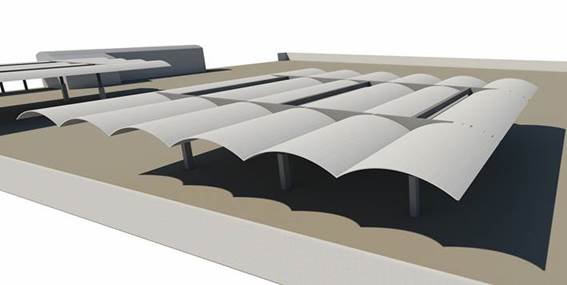
Source: Laura Henao, 2018, CC BY.
Figure 9 Digital reconstruction of the roof system in building [c]
For its part, the largest roof was the one that covered the workshop area, or building [d], which was formed by 3 aligned vaults 24 m long and 16 m wide each, supported by cable-stayed arches, which, at the same time, were supported on circular columns with a diameter of 30 cm. The three vaults, identical and continuous, had a deflection of 2 m in height. Next to them, but in a perpendicular sense, there was a set of 14 membranes of lower height that covered building [e], 4.8 m wide and 8 m long, confined at their end walls by edge beams supported on columns (Figure 10). In all cases, waterproofing was achieved, according to the authors of the project, with a lime-based plaster on the upper face of the vaults and direct water discharge on the pavement.
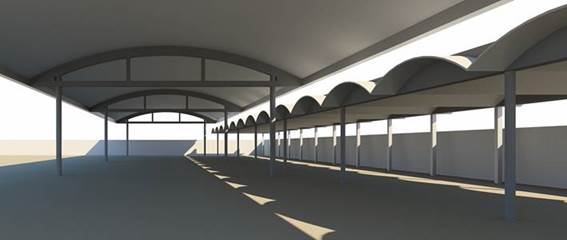
Source: Laura Henao, 2018, CC BY
Figure 10 Digital reconstruction of the roof system of building [d], in the foreground, and of building [e] on the right
In this project, transversal spans were modest and they were all perfectly modulated, which allowed using mobile wooden frameworks (Villazón, 2001) that were light and cheap, and of simple and economic handling. The membranes were constructed in such a way that in the joints (10 and 12 cm thick), between the bricks (of 38 x 23 cm), the armor formed by 3/8” steel bars was arranged in such a way they could work when the concrete had completely hardened. In the valleys between the membranes, thrusts were neutralized by reinforcing them with four ¼” bars embedded in concrete.
The building not only came to be included in the sample presented by Hitchcock for the Museum of Modern Art in New York in 1955 (Hitchcock, 1955), but also served as an example to illustrate articles such as the one published in the journal Architectural Forum (Shell Concrete Today, 1954), which reviewed important projects with laminar structures from around the world, as a summary of the academic event organized on the subject by the Massachusetts Institute of Technology (MIT), in Boston, in June of 1954.
Unfortunately, the building was entirely demolished at the end of the 1970s, but its influence was remarkable: an unsigned article from the journal Proa (No. 50, August 1951) recorded photographs of the finished project and was preceded by an editorial note entitled “The binomial architect-engineer,” where both kinds of professionals were urged to have a greater dialogue about projects.
The Volkswagen Headquarters
Designed by the Italian architect Bruno Violi, the structural calculations of roof membranes were made by Guillermo González Zuleta.4 With its main facade on the important 26th street in Bogotá (a highway that quickly connects the center of the city with the airport), the building occupied an area almost equivalent to a block and was dedicated to accommodate several functions for the Volkswagen headquarters. In spite of the property’s irregularities, the structure was organized on a mesh that was close to a module of 6 m, and it was equal to the width of the largest cylindrical roof shells.
The main body [a] (Figure 11), on the 26th Street, was formed by a two-level structure; the first level had double height: 5.35 m, with a mezzanine on the front, while the second was of 3.2 m high, covered by a set of six circumference-segment membranes of 23 m long, 5.93 m wide, and with a depth of 1.05 m.
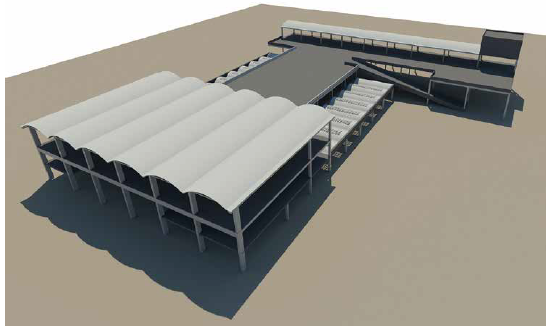
Source: Laura Henao, 2018, CC BY
Figure 11 Digital reconstruction of the building’s structural and roof system
Each of these main membranes were supported on three parallel arches of 40 cm wide, supported by a horizontal beam of 15 cm high, in such a way that they formed identical number of axes separated from each other by distances of 6 and 15 m, respectively. At each end, the membranes had a cantilever of 1 m. Its construction was carried out taking into account previous experiences: bricks (5 cm thick and 23 x 38 cm in area) were separated from each other by girders of 10 cm wide that were reinforced with four 3/8” bars. In the areas near the valleys, the entire membrane was made of concrete reinforced with ½” bars in the vicinity of ceramic pieces, and with 5/8” bars at the point of membrane inflection. Reinforcements were uniquely arranged in areas where membranes were located above the supporting arches, which constituted a supplementary reinforcement of a square plan with 3/8” bars spaced 20 cm from each other (Figure 12).
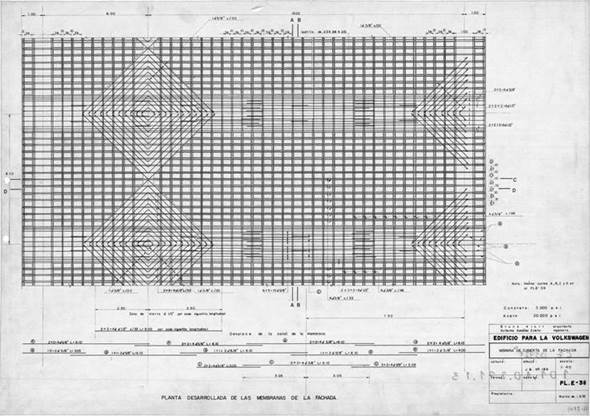
Source: Archive of Bogotá, Plano 101.10.271.13, Fund Guillermo González Zuleta.
Figure 12 Detail of reinforcements of the facade membranes
The necessity of an optimal drainage system required that membranes extend 50 cm outside the plane of the front and back facades, to allow free transit for the downpipes until the floor level.
Additionally, a reinforced concrete slab was extended towards the back of the property, simultaneously serving as a cover for the areas dedicated to the maintenance of cars and as a parking surface for other cars, which could be reached through a ramp. On the lower side of the plate, supported by circular columns separated from each other by a distance of 12 m, clearly visible prismatic beams were arranged in two directions that formed structural porticos and ended in cantilevers of 3.5 m long on each side.
It is of great interest how two rectangular areas, or building [b], were covered by two sets of membranes. One of them had 9 sinusoidal shells and the other had 8; all of them were 8.8 m long and 4 m wide, with their longitudinal ends confined in an edge beam. While one end of this beam rested on the dividing wall, the other was suspended, by means of concrete columns, from the cantilever of the highest concrete slab, forming a zenith opening between both surfaces through which the air circulated (Figure 13).
In order to further illuminate the space on the first floor, the membranes framed in the moderately suspended structure were constructed with pieces of isolux arranged like structural bricks, following the model proposed by Rother in the central membranes of the Girardot market. The drainage of this series of membranes was achieved through vertical downpipes located in the posterior plane in such a way that water was taken to them through a gentle slope of the surface of the valleys.
Finally, building [c], also destined to car storage, covered its second floor with a series of 8 aligned membranes that ended against an elevated water tank, each 6 m long and 5.93 m wide. As in the previous cases, they were only 5 cm thick.
Discussion
Table 1 presents a comparative look at the three cases studied here, based on the dimensional aspects described.
Table 1 Dimensional attributes of the cylindrical shells in the buildings under study
| [1] Project | GIRARDOT MARKET | BUS TERMINAL | VOLKSWAGEN HEADQUARTERS | |||
|---|---|---|---|---|---|---|
| [2] Construction period | 1946-1954 | 1950-1951 | 1954-1955 | |||
| [3] Covered area | 3,465 m2 | 2,130.8 m2 | 1,630.22 m2 | |||
| [4] Radius (r) | 1.68 m | Building [a] | 4.5 m | Building [a] | 4.9 m | |
| Building [b] | 4.5 m | |||||
| Building [c] | 4.5 m | Building [b] | 2 m | |||
| Building [d] | 16 m | Building [c] | 4.9 m | |||
| Building [e] | 4.5 m | |||||
| [5] Width (w) | 2.5 m | Building [a] | 4.8 m | Building [a] | 5.93 m | |
| Building [b] | 4.8 m | |||||
| Building [c] | 4.8 m | Building [b] | 4 m | |||
| Building [d] | 16 m | Building [c] | 5.93 m | |||
| Building [e] | 4.8 m | |||||
| [6] Thickness (t) | 5 cm | 5 cm in each case | 5 cm in each case | |||
| [7] Length (l) | 7 m | Building [a] | 24 m | Building [a] | 23 m | |
| Building [b] | 21.2 m | |||||
| Building [c] | 21.2 m | Building [b] | 8.8 m | |||
| Building [d] | 24 m | Building [c] | 6 m | |||
| Building [e] | 8 m | |||||
| [8] Depth (e) | 60 cm | Building [a] | 80 cm | Building [a] | 105 cm | |
| Building [b] | 80 cm | |||||
| Building [c] | 80 cm | Building [b] | 80 cm | |||
| Building [d] | 200 cm | Building [c] | 80 cm | |||
| Building [e] | 80 cm | |||||
| [9] Ratio r/L | 0.24 | Building [a] | 0.19 | Building [a] | 0.21 | |
| Building [b] | 0.21 | |||||
| Building [c] | 0.21 | Building [b] | 0.23 | |||
| Building [d] | 0.67 | Building [c] | 0.82 | |||
| Building [e] | 0.56 | |||||
| [10] Construction material | Reinforced ceramics | Reinforced ceramics | Reinforced ceramics | |||
Source: Own elaboration, 2018.
The analysis of the data collected in Table 1 allows identifying several construction aspects:
The value of the curvature radius of cylindrical shells was preferably in ranges that would allow a simple setting and layout (between 2 and 4.5 m in most of the cases).
Membrane width (without resorting to bracing) ranged between 4.8 and 6 m.
In all cases, thickness (5 cm) was almost certainly determined by the size of the bricks they were built with.
Length was one of the best used virtues of cylindrical shells (up to 24 m).
The depth of cylindrical shells exceeded that of traditional prismatic beams, with a minimum investment of materials, low-mass and low own weight.
In practically all cases, Colombian architects and engineers opted for the construction of long cylindrical shells (r/L<0.6).
Based on the contextualization of the cases studied here, it is possible to deduce that, at the local level, the adoption of the forms of the so-called modern architecture and its international language also implied the assimilation of techniques that allowed that these would become a material reality. This necessarily demanded a process of constructive experimentation that progressively overcame the dimensional limitations of cylindrical shells.
This process, experimental in its nature, could not be done without the structural analysis methods developed in civil engineering in the first decades of the 20th century; and although construction professionals had to employ a high degree of structural intuition, this cannot be considered as the only tool to achieve new constructed forms. It has been demonstrated that in the country, the teaching of numerical calculation methods was at the service of conception and execution processes developed by Colombian engineers and architects.
It is also observed that, as part of this new technological conceptualization, the notion of “module” acquired a value that went beyond the aesthetic to become an instrument of rationalization in the construction process: the structural meshes of the analyzed projects demonstrate this, as well as a close relationship between the dimensions of structural axes and their multiples and submultiples, and the size of roof membranes; in turn, the latter was conditioned by the size of the formwork, which had to be reused.
It is interesting to note the importance the concept of a building’s “own weight” was achieving, as well as the attempt to reduce it not only for the sake of its formal appearance (associated with the concepts of lightness and transparency), but also as a mechanical aspect that helped to lower construction costs in general. This search allowed, in the Colombian case, adopting the technique of reinforced ceramics as a principle in the execution of cylindrical shells, anticipating other Latin American experiences in this area, and, in particular, the work developed by Eladio Dieste in the south of the continent.
Finally, it is important to emphasize that given that functionality was the dominant factor in the studied cases, and that none of the studied buildings achieved the status of a building-manifest or technological paradigm, the historiography of Colombian architecture has considered them as transitory links in the process of technological innovation, which opened the way to buildings with greater national impact.
Consequently, there was no due attention paid to smaller-scale projects that adopted, among other innovative structural solutions for their time, cylindrical shells as roofing systems. Thus, it is important not to ignore the close relationship that existed between spatial and technical values in projects such as the CINVA headquarters, covered with a laminar vault with an elliptical profile, which was built in 1953 on the premises of the Universidad Nacional de Colombia by the firm Alberto Manrique Martín and sons, following the designs of Ritter and Mejía, with structural calculations by the engineer Carlos Valencia.
The project developed by the architect Álvaro Hermida in collaboration with the engineer Guillermo González Zuleta for the Hippodrome of Techo (1953-1955) was also important, where the roof of the main grandstand is made up of 12 cylindrical concrete shells arranged in parallel above the stands, which reach a length of 66 m and a thickness of –" (1.875 cm), confined between a series of porticoes that are 10 m apart from each other (Figure 14).
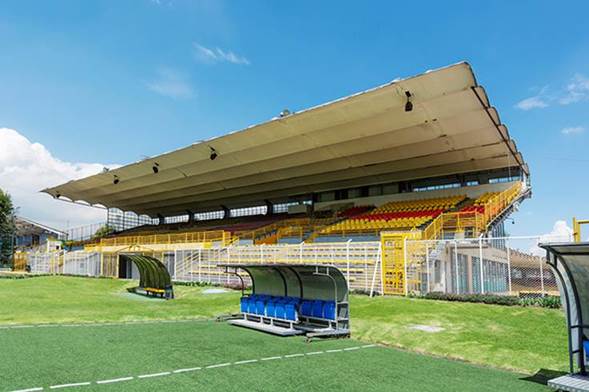
Source: Own elaboration, 2018, CC BY
Figure 14 Current view of the main grandstand of the Hippodrome of Techo
Beyond the capital, projects such as the building of the new market place in Buga (1960), designed by the local architect Diego Salcedo, took advantage of the climatic advantages of cylindrical shell covers, introducing a modern architectural language with a careful construction quality expressed in the quality of formworks, overhead lighting, and cross ventilation (Figure 15).
Conclusions
The works described and analyzed here demonstrate a close relationship between architectural form, structural system, and constructive rationality in some projects carried out by Colombian architects at the beginning of the second half of the 20th century, which is expressed in cases where covers were conceived based on laminar beams with a circular profile.
A close collaborative work between architects and engineers allowed the construction of buildings where technical experimentation was possible based on calculation methods and simplified structural analysis, in addition to a high level of intuition about their mechanical behavior, using materials that ensured an easy execution process at low costs and over a relatively short time period.
The formal results, both in the Colombian and Latin American context, are remarkable. In addition to dimensional characteristics (width, span, thickness), it is important to recognize the achieved spatial richness, where enclosures lose the prominence and importance they had in the preceding architecture, but leaving intact not only the supporting function of the structure, but also a mandate about the general composition of the building. In addition, there was achieved a harmony with the place’s climatic conditions (very relevant in the case of the Girardot market), as well as with environmental determinants imposed by use (vehicle workshops, storage areas, etc.).
Once the advantages of this structural system were endorsed, its application was extended to numerous projects of very diverse scales, although its most significant examples can be found in functional buildings that have not been sufficiently studied, despite being paradigmatic in their conception and development processes. Although in the Colombian context surfaces of double curvature or concrete shells of the hyperbolic paraboloid type were not as frequently used as in Mexico, this probably was due to economic and cultural limitations rather than to a lack in the management and control of their technical aspects.
The lessons for the future offered by this structural design gain importance in a moment when a dissociation of knowledge in the field of architecture and a fracture between design and construction become increasingly more frequent. They are even more useful at present, when computer resources, especially those related to 3D modeling and digital printing, allow resuming the design use of laminar structures with new materials other than concrete or reinforced ceramics, and when professional practice has an increasingly interdisciplinary character.
1 The headquarters of the Inter-American Housing Center (CINVA) were built on the premises of the Universidad Nacional de Colombia, and today it houses the university’s School of Architecture.
2 While the Jena dome is often considered a pioneer in the field of thin shell structures, recent studies (Picon, 1997) mention some preceding cases, such as the cover of the Bercy-Paris station, built by the French engineer S. Boussiron in 1910. A detailed review of the first editions of the journal Le béton armé, through which the Maison Hennebique promoted constructions developed in several countries of the world that made use of its system, allows recognizing the earliest experiences in the field of laminar structures, including the dome over the Brunner banking house in Brussels (1900), the dome of the Museum of Egyptian Antiquities in Cairo (1900) during some years, and the hemispheric dome of the Courthouse at Sousse, in Tunis (1907); all of them made known through this publication. These examples did not yet have an effective and reliable structural.
3 For similar reasons, companies such as Dywidag, or renowned engineers such as Eduardo Torroja or Pier Luigi Nervi, frequently resorted to scale models as tools that allowed verifying stress states and deformation phenomena (Moreno & Fernández-Llebrez, 2017).
4 The preliminary plans signed by B. Violi, which are in the Archive of Bogotá, are dated November 1954, and the construction plans with details of the reinforcements made in González Zuleta’s office date from March 1955, folders 101-10-271 and 101-10-272. Given that the number 93 of the journal Proa from October 1955 published an article with photos of the building in its final stage of construction, it is clear the brief time invested in its designs
Referencias
Arango, S. (1989). Historia de la arquitectura en Colombia. Bogotá: Universidad Nacional de Colombia. [ Links ]
Archivo de Bogotá. (1955, Marzo). Edificio para la Wolkwagen. [Plano estructural]. Fondo Guillermo González Zuleta (Plano 101.10.271.13. PL.E-38 ). [ Links ]
Archivo General de la Nación (1949, julio 27). Mercado de Girardot. [Planimetría, Corte longitudinal]. Fondo INVIAS (Mapoteca 1, Planoteca 03, Bandeja 09, Ref. 171). Bogotá [ Links ]
ASCE American Society of Civil Engineers (1952). Design of Cylindrical Concrete Shell Roofs. Manual of Engineering Practice, 31. New York: ASCE. [ Links ]
Billington, D. (1965). Thin Shell Concrete Structures (1ª ed.). New York: McGraw-Hill. [ Links ]
Billington, D. (2013). La torre y el puente. El nuevo arte de la ingeniería estructural. Madrid: Cinter. [ Links ]
Bonnelly, R. (1942). Bóvedas membranas. Ingeniería y Arquitectura, 40: 18-21. [ Links ]
Bonnelly, R. (1945). Bóvedas membranas. Ingeniería y Arquitectura, 62: 3-6. [ Links ]
Bóvedas membrana (1950). Proa, 50: p.14-18. [ Links ]
Buonopane, S. & Osanov, M. (2015). Evaluation of August Komendant’s Structural Design of the shells of The Kimbel Art Museum. En: Bowen, B., Friedman, D., Leslie, T. y Ochsendorf, J. (eds.), Proceedings of the 5th International Congress on Construction History (vol. II). Chicago: Construction History Society of America, p. 283-290. [ Links ]
Cabeza, J. M. & Almodóvar, J. M. (1996). Las bóvedas de cerámica armada en la obra de Eladio Dieste. Análisis y posibilidades de adaptación a las condiciones constructivas españolas. En: De las Casas, A., Huerta, S. y Rabasa, E. (eds.): Actas del primer congreso nacional de historia de la construcción (p. 135-142). Madrid: Instituto Juan de Herrera y CEHOPU. [ Links ]
Candela, F. (1951). Hacia una nueva filosofía de las estructuras. En: Memoria del congreso científico mexicano (vol. V). México: Universidad Nacional Autónoma de México, p. 87-111. [ Links ]
Cassinello, P.; Schlaich, M. & Torroja, J. A. (2010). Félix Candela. En memorian (1910-1917). From thin concrete shells to the 21st century’s lightweight structures. Informes de la Construcción, 62(519), p. 5-26. DOI: https://doi.org/10.3989/ic.10.040. [ Links ]
Cornelissen, H. (1944). Bóvedas membranas de sección circular. Ingeniería y Arquitectura, 59: 5-10. [ Links ]
Devia, M. (2006). Leopoldo Rother en la ciudad universitaria. Bogotá: Universidad Nacional de Colombia . [ Links ]
Engel, H. (1970). Sistemas de estructuras. Madrid: Blume. [ Links ]
Escobar, A. & Cárdenas, M. (2006). Hitos y protagonistas. En: Asociación colombiana de productores de concreto (ed.): La construcción del conceto en Colombia (p. 44-132). Bogotá: Panamericana. [ Links ]
García, R. (2017). Láminas cilíndricas en España. El reinicio de la construcción laminar en los años de la posguerra. En: Huerta, S., Fuentes, P. y Gil, I. (eds.): Actas del décimo congreso nacional y segundo congreso internacional hispanoamericano de historia de la construcción (vol. II). (p. 669-678). Madrid: Instituto Juan de Herrera, Escuela Técnica Superior de Arquitectura de Madrid. Recuperado de: http://oa.upm.es/49287/1/INVE_MEM_2017_268257.pdf. [ Links ]
García, R. & Osuna, R. (2009). Cubiertas laminares de hormigón tras la segunda guerra mundial. Soluciones en edificios industriales. En: Huerta, S., Marín, R., Soler, R. y Zaragozá, A. (eds.): Actas del sexto congreso nacional de historia de la construcción (vol. II) (p. 559-569.). Madrid: Instituto Juan de Herrera, Escuela Técnica Superior de Arquitectura de Madrid . Recuperado de: http://oa.upm.es/45162/1/2009%20Valencia%20Laminares%20industria.pdf. [ Links ]
Hitchcock, H. R. (1955). Latin American Architecture since 1945. New York: MOMA. [ Links ]
Johansen, K. W. (1944). Skallkonstruktion paa Radiohuset. Bygningsstatiske Meddelelser, (15): 1-26. [ Links ]
Lundgren, H. (1949). Cylindrical Shells . Volume 1: Cylindrical Roofs. Copenhagen: Danish Technical Press. [ Links ]
Martínez, M. & Evheverría, E. (2017). Las bóvedas cilíndricas y su evolución hacia las cáscaras cilíndricas largas de cubierta de Félix Candela. Análisis geométrico y mecánico. EGA Expresión gráfica arquitectónica, 22(30): 160-169. DOI: https://doi.org/10.4995/ega.2017.7846 [ Links ]
May, R. (2012). Shell Wars: Franz Dishinger and Ulrich Finsterwalder. En: Carvais, R., Guillerme, A., Nègre, V. y Sakarovitch, J. (eds.): Nuts & Bolts of Construction History (vol. III) (p. 133-141). París: Piccard. [ Links ]
May, R. (2015). Shell Sellers. The International Dissemination of the Zeiss-Dywidag System, 1923-1939 . En: Bowen, B., Friedman, D., Leslie, T. y Ochsendorf, J. (eds.): Proceedings of the 5th International Congress on Construction History (vol. II) (p. 557-564). Chicago: Construction History Society of America . [ Links ]
Morales, M. (2009). Cubiertas formadas por paraboloides hiperbólicos: ventajas en su funcionamiento estructural y en su construcción. En: Huerta, S., Marísn, R., Soler, R. y Zaragozá, A. (eds.): Actas del sexto congreso nacional de historia de la construcción (vol. II) (p. 939-945.). Madrid: Instituto Juan de Herrera y CEHOPU . Recuperado de: http://www.sedhc.es/biblioteca/actas/CNHC6_%20%2888%29.pdf. [ Links ]
Moreno, P. & Fernández-Llebrez, J. (2017). Aportaciones de modelos físicos al desarrollo y construcción de estructuras laminares en el s. XX. En: Huerta, S., Fuentes, P. y Gil, I. (eds.): Actas del décimo congresonacional y segundo congreso internacional hispanoamericano de historia de la construcción (vol. II) (p. 1103-1112). Madrid: Instituto Juan de Herrera. [ Links ]
Niño, C. (2003). Arquitectura y estado: contexto y significado de las construcciones del Ministerio de Obras Públicas, Colombia, 1905-1960. Bogotá: Universidad Nacional de Colombia. [ Links ]
Picon, A. (1997). L’art de l’ingénieur. París: Centre Georges Pompidou. [ Links ]
Pinilla, M. (2017). De Prusia a la cuenca del río Magdalena. La tradición clásica fecundada por el trópico en la arquitectura de Leopoldo Rother. Tesis doctoral. Bogotá: Universidad Nacional de Colombia . [ Links ]
Pucher, A. (1943a). Sobre la función de tensión en las cúpulas delgadas curvadas de modo cualquiera (parte I). Ingeniería y Arquitectura, 50(V): 50-59; [ Links ]
Pucher, A. (1943b): Sobre la función de tensión en las cúpulas delgadas curvadas de modo cualquiera (parte II). Ingeniería y Arquitectura, 53-54(V): 25-30. [ Links ]
Pucher, A. (1958). Curso de hormigón armado. Buenos Aires: El Ateneo. [ Links ]
Rother, H. (1984). Arquitecto Leopoldo Rother, Vida y obra. Bogotá: Escala. [ Links ]
Rother, L. (1967). Plaza de mercado de Girardot. Escala, 20: 4-6. [ Links ]
Salvadori, M. & Heller, R. (1966). Estructuras para arquitectos. Buenos Aires: Ediciones La Isla. [ Links ]
Shell Concrete Today (1954). Architectural Forum, 101(1): 157-166. [ Links ]
Stegmann, K. (2009). Early Concrete Construction in Germany - A Review with Special Regard to the Building Company Dyckerhoff & Widmann. En: Kurrer, K.E., Lorenz, W. y Wetzk, V. (eds.): Proceedings of the Third International Congress on Construction History (p. 1371-1378). Cottbus: Brandenburg University of Technology. [ Links ]
Torroja, E. (1936). La cubierta laminar del frontón Recoletos. Manuscrito original perteneciente al Archivo Torroja depositado en el CEHOPU, Madrid. Recuperado de: http://www.cehopu.cedex.es/img/bibliotecaD/Cubierta_laminar_fronton_recoletos. [ Links ]
Torroja, E. (1957). Razón y ser de los tipos estructurales. Madrid: Instituto de la Construcción y el Cemento, Consejo Superior de Investigaciones Científicas. [ Links ]
Vargas, H. y Galindo, J. (2015). The Construction of Thin Concrete Shell Rofs in Colombia During the First Half of the 20th Century: The Works of the Guillermo González Zuleta (1916-1995). En: Bowen, B., Friedman, D., Leslie, T. y Ochsendorf, J. (eds.): Proceedings of the 5th International Congress on Construction History (vol. III) (p. 525-534). Chicago: Construction History Society of America . [ Links ]
Villazón, R. (2001). Álvaro Ortega: la arquitectura como acto técnico. Arquitecturas, 7(1): 44-45. [ Links ]
Received: April 18, 2018; Revised: June 18, 2018; Accepted: July 23, 2018











 texto em
texto em 


